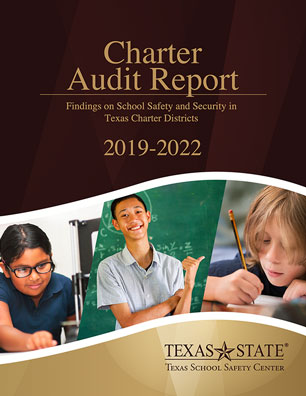TxSSC
2019-2022 Charter District Audit Report (CAR)
Findings on School Safety and Security in Texas Charter Districts

The purpose of the CAR is to provide key results of the safety and security audits completed by Texas public charter districts. In accordance with procedures developed by the Texas School Safety Center (TxSSC) or an equivalent public or private entity, the Texas Education Code (TEC) requires charter districts to complete safety and security audits of their facilities once every three years (§37.108 (4)(b)). A summary of the findings is then submitted to the TxSSC and incorporated as aggregate data into a statewide report for the public (§37.108 (4) (c)) (§37.207(3)).
The TxSSC provides guidance for charter districts to develop safety and security audit procedures as well as tools to assist in the assessments. (§37.207 (1)). The TxSSC Safety and Security Audit toolkit includes step-by-step guidance and job aids for conducting audits, as well as comprehensive district facility audit checklists. The toolkit contains a series of spreadsheets utilizing specific evaluation statements for a variety of facilities and functions. These statements are a combination of best practices, promising practices, and/or requirements appropriate for certain types of facilities. The model safety and security audit procedures developed by the TxSSC are intended for use by charter districts to conduct a "self-assessment" of safety and security in their facilities.
While the term "audit" is included in TEC §37.108 and used throughout this report for consistency, the process was developed as an ongoing self-assessment of a charter district's safety and security. Audits should be an ongoing process of identifying specific district, campus or facility hazards, threats, and vulnerabilities and making improvements in safety and security plans and processes.
“The purpose of the CAR is to provide key results of the safety and security audits completed by Texas public charter districts.”
Methodology
The CAR provides a summary of safety and security information, which is an aggregate of self-reported data submitted by charter districts in the state of Texas. The TxSSC collected specific safety and security audit information from the September 1, 2019 to August 31, 2022 audit cycle to create this report for the Texas Legislature.

The CARtool was comprised of six sections containing 49 single and multi-part questions. Below is a description of each section included in the CARtool:
- Section 1 included charter district demographic items such as the name of the person reporting for the district, the type of geographical area where the majority of students in the district live, and cumulative district enrollment.
- Section 2 encompassed questions regarding the safety and security audit process such as how many facilities were present in the district and the elements reviewed during district safety and security audits.
- Section 3 included questions regarding school safety and security committee composition and operations.
- Section 4 included questions pertaining to emergency management processes such as district multi-hazard emergency operations plan (EOP) composition and practices.
- Section 5 included questions about behavioral threat assessment, suicide prevention and trauma-informed care information.
- Section 6 contained additional safety and security information questions that assessed programs and practices not necessarily mandated by law in an attempt to provide the TxSSC and the Texas Legislature with supplemental information regarding the efforts of charter districts to establish model safety and security practices.
The TxSSC collected safety and security audit information from all 182 charter districts in Texas (100% response rate). The data collection period began on April 15, 2022 and concluded on September 15, 2022.
Key Findings
- 171 of the 182 (94%) charter districts reported completing audits for all the instructional facilities in their charter district.
- 92 of the 182 (50.5%) charter districts reported that audits were not completed at any of their non-instructional facilities in their charter district.
- 181 of the 182 (99.5%) charters districts reported having a school safety and security committee.
- 175 of the 182 (96.2%) charter districts reported adopting a multi-hazard emergency operations plan (EOP).
- 176 of the 182 (96.7%) charter districts reported having bullying prevention programs in place.
- 176 of the 182 (96.7%) charter districts reported conducting after-action reviews following drills.
- 178 of the 182 (97.8%) reported identifying key personnel responsible for specific emergency functions.
- 159 of the 182 (87.4%) charter districts reported having a reunification plan or process in place.
Recommendations
The findings from the 2019-2022 audit cycle identified ten key areas to serve as recommendations for improvement toward the safety and security of charter districts in Texas. These recommendations serve to assist charter districts to prevent/mitigate, prepare for, respond to, and recover from potential hazards, and will aide in the overarching goals of safety and emergency management—saving lives and protecting property.
- Charter districts must continue to develop and implement multi-hazard emergency operations plans (EOP).
- Charter districts are encouraged to continue designating individuals in emergency management or safety coordinator roles.
- Charter districts should conduct safety and security audits of all instructional and non-instructional facilities.
- Charter districts should develop a process to ensure the timely reporting of their safety and security audit results to the district’s board of trustees.
- Charter districts should practice their reunification plan or process, at a minimum, on an annual basis.
- Charter districts should develop an active shooter policy that should be part of an overall active threat annex.
- Comprehensive hazard analysis should be conducted as part of the charter district’s multi-hazard EOP.
- Charter districts should establish School Behavioral Threat Assessment (SBTA) Teams.
- Charter districts should establish an anonymous reporting system to report bullying.
- Charter districts should adopt National Incident Management System (NIMS) and Incident Command System (ICS) training as part of their EOP.
Refer to the full Recommendations section on pages 35-38 for details and resources pertaining to each recommendation.